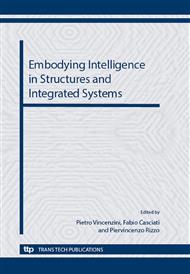[1]
W. Musial, S. Butterfield, Energy from offshore wind, Offshore Technology Conference, Houston (2006).
DOI: 10.4043/18355-ms
Google Scholar
[2]
M. Kühn, Dynamics and design optimisation of offshore wind energy conversion system, PhD thesis, Delft University of Technology (2001).
Google Scholar
[3]
K.E. Johnson, L.Y. Pao, M.J. Balas, L.J. Fingersh, Control of variable-speed wind turbines: standard and adaptive techniques for maximizing energy capture, IEEE Control Systems Magazine (2006).
DOI: 10.1109/mcs.2006.1636311
Google Scholar
[4]
B. Skaare, T. Hanson, F.G. Nielsen, Importance of control strategies on fatigue life of floating wind turbines, Int. Conf. Offshore Mechanics and Arctic Eng. (2007).
DOI: 10.1115/omae2007-29277
Google Scholar
[5]
J. Van der Tempel, Design of support structures for offshore wind turbines, PhD thesis, Delft University of Technology (2006).
Google Scholar
[6]
W. Musial, S. Butterfield, A. Boone, Feasibility of floating platform systems for wind turbines, ASME Wind Energy Symposium, Reno, Nevada, USA (2004).
DOI: 10.2514/6.2004-1007
Google Scholar
[7]
J. Jonkman, Dynamics modeling and loads analysis of an offshore floating wind turbine, PhD thesis, University of Colorado, USA (2007).
DOI: 10.2172/921803
Google Scholar
[8]
E.N. Wayman, P.D. Sclavounos, S. Butterfield, J. Jonkman, W. Musial, Coupled dynamic modelling of floating wind turbine systems, Offshore Technology Conf., Houston, Texas, USA (2006).
DOI: 10.4043/18287-ms
Google Scholar
[9]
H. Suzuki and A. Sato, Load on turbine blade induced by motion of floating platform and design requirement for the platform, Int. Conf. Offshore Mechanics & Arctic Eng., San Diego, USA (2007).
DOI: 10.1115/omae2007-29500
Google Scholar
[10]
S. Shim, M.H. Kim, Rotor-floater-tether coupled dynamic analysis of offshore floating wind turbines, Int. Offshore Polar Eng. Conf., Vancouver, Canada (2008).
DOI: 10.1115/omae2010-20555
Google Scholar
[11]
B. Skaare, T. Hanson, F.G. Nielsen, Integrated dynamic analysis of floating offshore wind turbines, European Wind Energy Conf. & Exhibition, Athens, Greece (2006).
DOI: 10.1115/omae2006-92291
Google Scholar
[12]
M. Klose, P. Dalhoff, K. Argyriadis, Integrated load and strength analysis for offshore wind turbines with jacket structures, Int. Offshore and Polar Eng. Conf., Lisboa, Portugal (2007).
Google Scholar
[13]
N. Luo, C.L. Bottasso, H.R. Karimi, M. Zapateiro, Analysis and mitigation of dynamic loads in floating offshore wind turbines, Advances in Dynamics, Control, Monitoring and Applications, UPC-Tech, Barcelona (2011).
DOI: 10.24084/repqj09.449
Google Scholar
[14]
A. Umar, T.K. Datta, S. Ahmad, Complex dynamics of slack mooring system under wave and wind excitations, The Open Oceanography Journal (2010).
DOI: 10.2174/1874252101004010009
Google Scholar
[15]
X.H. Chen, J. Zhang, W. Ma, On dynamic coupling effects between a spar and its mooring lines. Ocean Engineering (2001).
DOI: 10.1016/s0029-8018(00)00026-3
Google Scholar
[16]
Z. Ran, M.H. Kim, W. Zheng, Coupled dynamic analysis of a moored spar in random waves and currents, J. Offshore Mechanics and Arctic Engineering (1999).
DOI: 10.1115/1.2829565
Google Scholar
[17]
B. Teng, M.D. Yang, Nonlinear coupled dynamic analysis for waves and a moored platform in time domain, Int. Workshop on Water Waves and Floating Bodies, Athens, Greece (2011).
Google Scholar
[18]
B. Skaare, T. Hanson, F.G. Nielsen, Importance of control strategies on fatigue life of floating wind turbines, Int. Conf. Offshore Mechanics and Arctic Eng., San Diego, USA (2007).
DOI: 10.1115/omae2007-29277
Google Scholar
[19]
K.E. Johnson, L.Y. Pao, M.J. Balas, L.J. Fingersh, Control of variable-speed wind turbines: standard and adaptive techniques for maximizing energy capture, IEEE Control Systems Magazine (2006).
DOI: 10.1109/mcs.2006.1636311
Google Scholar
[20]
L. Acho, Y. Vidal, M. Zapateiro, F. Pozo, N. Luo, Chattering control design on a variable-speed horizontal-axis wind turbine, IEEE Industry Application Society - Seminar on Advanced Industrial Control Applications, Barcelona, Spain, November (2011).
DOI: 10.1201/b16587-14
Google Scholar
[21]
N. Luo, Semiactive control strategies for vibration reduction in smart structures, Advances in Control Systems Theory and Applications, 174-190, USTC Press, Hefei, China (2009).
Google Scholar
[22]
M. Zapateiro, H.R. Karimi, N. Luo, Semiactive vibration control of offshore wind turbine towers with tuned liquid column dampers using H-infinity output feedback control, IEEE Multi-conference on Systems and Control, Yokohama, Japan (2010).
DOI: 10.1109/cca.2010.5611186
Google Scholar
[23]
N. Luo, Smart structural control strategies for the dynamic load mitigation in floating offshore wind turbines, Int. Workshop on Advanced Smart Materials and Smart Structures Technology, Dalian, China (2011).
Google Scholar
[24]
N. Luo, C.L. Bottasso, H.R. Karimi, M. Zapateiro, Semiactive control for floating offshore wind turbines subject to aero-hydro dynamic loads, Int. Conf. Renewable Energies and Power Quality, Las Palmas de Gran Canaria, Spain (2011).
DOI: 10.24084/repqj09.449
Google Scholar
[25]
K. Sakai, T. Takaeda, T. Tamaki, Tuned liquid column damper - new type device for suppression of building vibrations, Int. Conf. High-rise Buildings, Nanjing, China (1989).
Google Scholar
[26]
S.D. Xue, J.M. Ko, Y.L. Xu, Tuned liquid column damper for suppressing pitching motion of structures, Eng. Structures (2000).
DOI: 10.1016/s0141-0296(99)00099-1
Google Scholar
[27]
S.K. Yalla, A. Kareem, Optimum absorber parameters for tuned liquid column dampers, J. Structural Eng. (2000).
DOI: 10.1061/(asce)0733-9445(2000)126:8(906)
Google Scholar
[28]
S.K. Yalla, A. Kareem, J.C. Kantor, Semi-active tuned liquid column dampers for vibration control of structures, Eng. Structures (2001).
DOI: 10.1016/s0141-0296(01)00047-5
Google Scholar
[29]
S. Colwell, B. Basu, Experimental and theoretical investigations of equivalent viscous damping of structures with TLCD for different fluids, J. Structural Eng. (2008).
DOI: 10.1061/(asce)0733-9445(2008)134:1(154)
Google Scholar
[30]
S. Colwell, B. Basu, Tuned liquid column dampers in offshore wind turbines for structural control, Eng. Structures (2009).
DOI: 10.1016/j.engstruct.2008.09.001
Google Scholar


